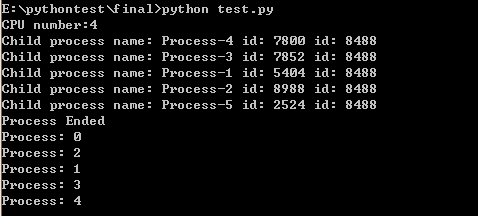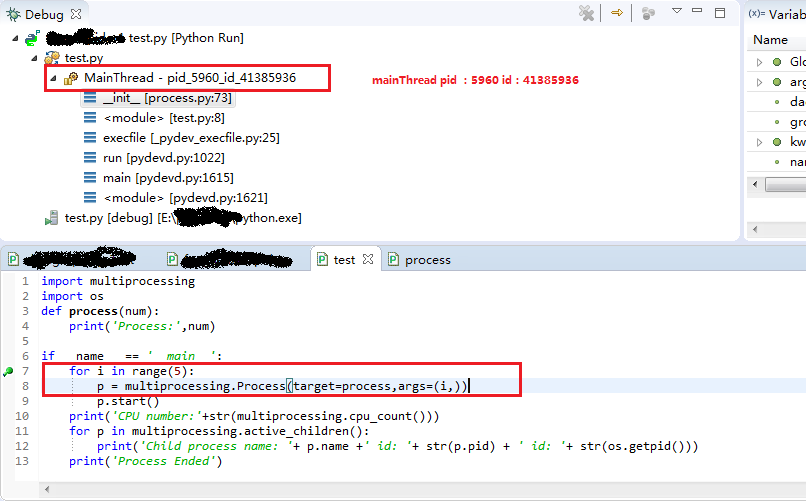2017.12.2学习记录------------------------------------------------------------------------------------------------------------------------------------
import multiprocessing
import os
def process(num):
print('Process:',num)
if __name__ == '__main__':
for i in range(5):
p = multiprocessing.Process(target=process,args=(i,))
p.start()
print('CPU number:'+str(multiprocessing.cpu_count()))
for p in multiprocessing.active_children():
print('Child process name: '+ p.name +' id: '+ str(p.pid) + ' id: '+ str(os.getpid()))
print('Process Ended')运行结果:
为什么这段代码先运行了呢?
print('CPU number:'+str(multiprocessing.cpu_count()))
for p in multiprocessing.active_children():
print('Child process name: '+ p.name +' id: '+ str(p.pid) + ' id: '+ str(os.getpid()))
print('Process Ended')p = multiprocessing.Process(target=process,args=(i,))
接下来进入
p.start()仍然处于start()中,下一步popen,这一过程很复杂,我也没完全看懂,不过结合api大致流程了解,准备数据
prep_data = spawn.get_preparation_data(process_obj._name)spawn
The parent process starts a fresh python interpreter process. The child process will only inherit those resources necessary to run the process objects run() method. In particular, unnecessary file descriptors and handles from the parent process will not be inherited. Starting a process using this method is rather slow compared to using fork or forkserver.
Available on Unix and Windows. The default on Windows.
然后给新创建的进程初始化属性,这里可以看到,self.pid就是pid。
关于sentinel的api解释:
-
A numeric handle of a system object which will become “ready” when the process ends.
You can use this value if you want to wait on several events at once using
multiprocessing.connection.wait(). Otherwise callingjoin()is simpler.
sentinel
可以看到这个子进程的pid是7560,_parent_pid父进程id是6816,分别与p.pid和os.getpid()的数值相吻合。
回到开始的那个问题,看了单步过程,似乎还是没有解决,
将代码改成
#coding:utf-8
import multiprocessing
import os
import time
def process(num):
print('Process:',num)
if __name__ == '__main__':
for i in range(5):
cstart = time.time()
print('创建进程'+str(i)+':',cstart)
p = multiprocessing.Process(target=process,args=(i,))
print('进程'+str(i)+'创建完毕!'+'用时:',(time.time()-cstart))
sstart = time.time()
print('start进程'+str(i)+':',sstart)
p.start()
print('进程'+str(i)+'start完毕!'+'用时:',(time.time()-sstart))
print('CPU number:'+str(multiprocessing.cpu_count()))
cpu_time = time.time()
for p in multiprocessing.active_children():
print('Child process name: '+ p.name +' id: '+ str(p.pid) + ' id: '+ str(os.getpid()))
print('cpu time '+p.name+':',time.time()-cpu_time)
print('cpu time',time.time()-cpu_time)
print('Process Ended')
真是好调皮哦。。。。。。在这个结果可以看出创建进程的时间在10^(-3)这个数量级上,而start进程的时间却在10^(-2)数量级上,所以这个过程应该是
p = multiprocessing.Process(target=process,args=(i,))cpu_time = time.time() 因为前面的创建过程都没有print语句,所以在控制台看到第一条输出是“CPU number:4”,接下来的语句都没有cpu操作,只有io操作,所以看到的是print('CPU number:'+str(multiprocessing.cpu_count()))这些语句的执行结果。for p in multiprocessing.active_children(): print('Child process name: '+ p.name +' id: '+ str(p.pid) + ' id: '+ str(os.getpid())) print('cpu time '+p.name+':',time.time()-cpu_time) print('cpu time',time.time()-cpu_time) print('Process Ended')最后回到start的执行结果。这里也可以发现,
process函数是在start()才调用的。target=process但是,还有一个问题,进程是独占CPU的,那么我创建了5个进程,外加主进程1个,也就是6个,而cpu只有4个,它是如何分配的呢?
2017.12.24学习记录-----------------------------------------------------------------------------------------------------------------------------------------------------------------------------------------------------
最近在房天下爬虫中用函数嵌套+多进程的过程时发现问题了,是Pool貌似必须传递参数。于是回头去学习Python官方文档multiprocessing模块。
这是文档给出的引例:
A prime example of this is the
Poolobject which offers a convenient means of parallelizing the execution of a function across multiple input values, distributing the input data across processes (data parallelism).
from multiprocessing import Pool def f(x): return x*x if __name__ == '__main__': with Pool(5) as p: print(p.map(f, [1, 2, 3]))
这个例子印证了混沌鳄鱼说的那句“如果没有参数就不要用pool了,pool就是为了把参数里的任务队列分配给进程池里的几个进程并行运算。”p.map相当于生成一个一对一映射,给了三个参数1,2,3,对应的分别生成三个子进程,执行结果如下:
[1, 4, 9]
接下来是Process模块,文档给出的例子是:In
multiprocessing, processes are spawned by creating aProcessobject and then calling itsstart()method.Processfollows the API ofthreading.Thread.通过Process创建的是单一个进程对象,对比与上面的map创建的是批量进程对象。
from multiprocessing import Process import os def info(title): print(title) print('module name:', __name__) print('parent process:', os.getppid()) print('process id:', os.getpid()) def f(name): info('function f') print('hello', name) if __name__ == '__main__': info('main line') p = Process(target=f, args=('bob',)) p.start() p.join()
对于多进程的start方法,是具有平台依赖性的,也就是说unix和windows上的start方法具体实现是不同的,因为我还没学用linux,就只看win的,Windows上start方法的具体实现是spawn()
-
spawn
-
The parent process starts a fresh python interpreter process. The child process will only inherit those resources necessary to run the process objects
run()method. In particular, unnecessary file descriptors and handles from the parent process will not be inherited. Starting a process using this method is rather slow compared to using fork or forkserver.Available on Unix and Windows. The default on Windows.
-
The parent process uses
os.fork()to fork the Python interpreter. The child process, when it begins, is effectively identical to the parent process. All resources of the parent are inherited by the child process. Note that safely forking a multithreaded process is problematic.Available on Unix only. The default on Unix.
forkserver
-
When the program starts and selects the forkserver start method, a server process is started. From then on, whenever a new process is needed, the parent process connects to the server and requests that it fork a new process. The fork server process is single threaded so it is safe for it to use
os.fork(). No unnecessary resources are inherited.Available on Unix platforms which support passing file descriptors over Unix pipes.
-
fork
关于手动设置start方法的例子给出:(当然Windows上用不上)
import multiprocessing as mp
def foo(q):
q.put('hello')
if __name__ == '__main__':
mp.set_start_method('spawn')
q = mp.Queue()
p = mp.Process(target=foo, args=(q,))
p.start()
print(q.get())
p.join()
另外还可以通过get_context()方法来改变start的选择,略。。。。。。



























 560
560











 被折叠的 条评论
为什么被折叠?
被折叠的 条评论
为什么被折叠?








